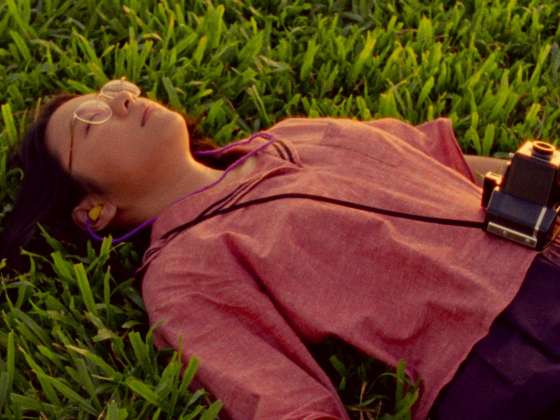Film Reviews: Boston Women’s Film Festival
All of Shirkers demonstrates the wonderfulness of making cinema. I Am Not a Witch dramatizes the mystery and solidarity of accused witches.
Boston Women’s Film Festival
September 27 through 30
The Brattle Theatre in Cambridge and
The Museum of Fine Arts, Boston, MA
The Boston area’s leading festival for international films created by women begins tonight. The festival hosts panel discussions by leading figures in the media industry, bringing together creators and audiences for a weekend dedicated to celebrating the diversity and power of women’s cinema. Here are reviews of some of the upcoming movies by Arts Fuse critics.

A scene from “Shirkers.”
Shirkers
September 28, 6 p.m.
Can I call them, affectionately, crazy bitch Asians? I’m talking of the three snotty, happily misfit young women — Sandi Tan, Sophie Siddique, Jasmine Ng — who acted out against the tight-ass, authoritarian world of their native country by collaborating on an indie film which had the potential of jumpstarting New Singapore Cinema. The name of the 1992 feature was Shirkers, the same title as Sandi Tan’s 2018 “making of” documentary. The first was, tragically, never completed. The second, happily for all of us, exists, and it’s a gem, a treasure, the most delightful film about cinephelia since Ed Wood.
That the original film was written by Tan, then shot and filmed, had to do with the encouragement of one Georges Cardona, an American living in Singapore. He popped out of the woodwork to offer a film production class, which the trio of culture-hungry teens, weaned on rock music and underground comics, eagerly signed on to. There was nothing like it, and the instructor was film-crazy, and he imparted his love of cinema to his students. No matter that he was a little weird, and that his claims to a film background seemed slightly improbable: that he’s worked on Apocalypse Now, that one of the major characters in Sex, Lies, and Videotape was based on him.
Was he after his students in a sexual way? Not overtly, though there is something slightly Humbert Humbert about his cross-America trip with young Tan. He wanted something else, though, deeply treacherous and perverse. Shirkers was in the can, ready to be edited. That there is no film today, that the hearts of the three female filmmakers were broken, is all Georges Cardona.
What would Shirkers have been? Bits of the original film — a punk teenage killer road movie with a heroine named “S” — are scattered through the documentary as a tease. Some of it is awkward and campy like a lovable B” movie, some it is unconscious surrealism, like a scene in a green field with child ballet dancers. All of it passes the basic taste for arresting art: you never can predict what the next scene will bring you. All of it demonstrates the wonderfulness of making cinema.
— Gerald Peary
I Am Not a Witch
September 29, 4 p.m.
This debut feature by Zambian filmmaker Rungano Nyoni explores the phenomenon of witchcraft accusations in modern day Zambia. The film opens with an odd and stunning scene of middle-aged and elderly women, all accused of witchcraft, who live in a special ‘witch’ camp, a form of refuge that separates them from their villages.
A nine year old girl, Shula (played by newcomer Maggia Mulubwa) is accused of witchcraft by villagers and, after a makeshift trial, banished to the witch camp. But The fact that Shula is a young girl means that she is more sympathetic to others than her elderly counterparts; she is also a target for manipulation by Mr. Banda, a corrupt government official (played by Zambian TV star Henry BJ Phiri). Banda houses an accused witch in his mansion and she tries to mentor young Shula. The girl is used by Banda to identify criminals and comes to enjoy a strange period of glamorous media attention. The parallels to the Salem witch trials and the ‘fame’ of its young female accusers is noteworthy.
Nyoni visited witch camps in Zambia and Ghana to research the film, which strives for an unusual hybrid tone, part realistic documentary and part dreamy (and metaphorical) morality play. The film uses humorous visuals (Shula’s t-shirt has “#bootycall” embroidered on its front) to explore various cultural dichotomies and to, perhaps, soften the blow that accusations of witchcraft, with its attendant violence, are part of daily life. Targeted women know full well the ritual response: their denials won’t be believed. The anachronistic popularity of witchcraft is connected, ironically, to Western cultural aspirations. There’s a crass element of commercialism to the set-up; the camps are a tourist draw. I Am Not a Witch is subtly satirical, taking care to underline the performative nature of the witchcraft accusations and banishings. The accused witches, unified in their ostracism and their shared shame, project a grand and dignified image. The film’s visual power is at its most moving when it dramatizes the mystery and solidarity of these women.
— Peg Aloi

A scene from “On Her Shoulders.”
On Her Shoulders
September 30, 6:30 p.m.
Among the international crises lost amid the Trump era’s “Crazytown” is the fate of the Yazidi people in northern Iraq, whose lives in 2014 were irrecoverably destroyed by ISIS. A refugee crisis followed the systematic massacre of thousands of Yazidis as well as the abduction and ensuing sexual slavery by ISIS fighters of thousands more women and children. The survivors have only recently re-established themselves in their homes in recent months; horribly, there are growing signs that they are still not safe from further persecution.
On Her Shoulders is a sober reminder of their story. In particular, the story of one survivor, Nadia Murad, and her efforts to recount the horrors — to an international audience — that were inflicted on her and her family. The complex cultural and religious heritage of the Yazidi (and their persecution) is left for other films to explore. Here the focus is on raw survival. To call Nadia’s story “remarkable” tends to gloss over the theme at the heart of this documentary: it goes without saying that Nadia is an inspiring and important voice we all must hear. But reliving her horrors over and over exerts an enormous toll. Might this be more than anyone should have to bear to advocate for a cause? Are we — the audience who needs to hear her — asking too much?
The film narrative deals with the Yazidis and Nadia, but it enters a meta-filmic realm when it comments on the act of its making itself. What does it mean for Nadia to have one more camera in her face, forcing her to talk? We see her speak at the UN and earn potted praise from world leaders for her “strength” and “courage.” Nadia remains undeterred, but we are aware of how she is playing a game, harvesting international attention for a cause. We are present while she rehearses her speeches, seeing her edit her story to fit the ears of specific audiences. She wonders aloud if anyone can ever truly understand what she’s been through — we wonder as well, as her horrors are packaged and repackaged for the sake of arousing a public response. By the end of the film, viewers may become as exhausted as Nadia, whose fatigue, at having to reliving her trauma, comes off as an act of courage.
–– Neil Giordano
Tagged: Boston Women's Film Festival, Gerald Peary, I Am Not a Witch, Neil Giordano, Peg Aloi

